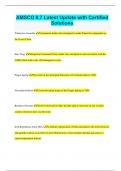Exam (elaborations)
Using Syntactic Distributional Patterns for Data-Driven Answer Extraction from the Web
- Course
- Institution
The Answer Extractor System Once a Natural-Language query triggers our QA system (QA-SYSTEM), this is sent out to Google so to retrieve a small number of snippets (i.e., usually 30), which are then normalized and cleaned up of math symbols and html tags. Next, the system performs the query anal...
[Show more]




